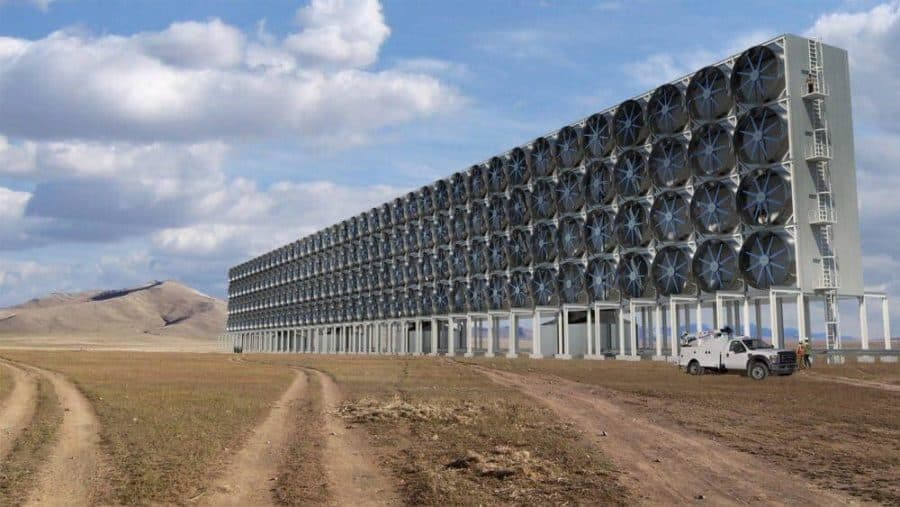As the Earth continues to heat up, so have calls to dramatically reduce carbon dioxide emissions to avoid catastrophic climate change. But many experts say that even if all emissions stopped tomorrow, the planet would continue to warm and seas would continue to rise.
A key issue is that atmosphere would still be clogged with 200 years’ worth of human-produced carbon dioxide. “The question is, what do we do with all this excess CO2 in the atmosphere?” said Noah Deich, executive director and co-founder of the nonprofit Center for Carbon Removal.
A new application of old technology may be the answer. “Direct air capture” that removes the gas from ambient air has been possible since the 1940s, but — at a cost estimated in 2011 to be as much as $1,000 per metric ton of CO2 — it has long been viewed as too expensive to be practical.
David Keith, the Gordon McKay Professor of Applied Physics at the Harvard John A. Paulson School of Engineering and Applied Sciences (SEAS) and professor of public policy at the Harvard Kennedy School, thinks it can be done for a lot less. He and his colleagues estimate that their company, Carbon Engineering, could capture CO2 for between $94 and $232 per metric ton. In the journal Joule, the team outlined the material and engineering costs of their system — the first time the costs of a commercial direct-air-capture process have been published.
The paper could have major ramifications across the industry.
“Until now, basically no one in the industry has published an open-book number that will give credibility that direct air capture costs less than the $500 to $1,000 per metric ton that has been estimated,” Deich said.
CO2 molecules make up only .04 percent of the air — that’s one in 2,500 molecules. Nonetheless, “We need enormous volumes of CO2 removal and to achieve that, we need accurate economic analysis and hard engineering data,” said Julio Friedmann, CEO of Carbon Wrangler LLC and senior advisor at The Global Carbon Capture and Storage Institute. “This paper provides that transparency.”
Keith co-founded Carbon Engineering in 2009, when direct air capture was still on the fringes of industrial climate solutions. Carbon Engineering’s goal is to use direct air capture to produce carbon-neutral fuels and converting carbon-free energy into high-energy fuels for vehicles such as planes and barges, which are difficult to electrify.
The Carbon Engineering team’s approach differs from their few competitors in the field.
“We’re not developing a fundamentally new product or unit operation,” said Keith. “That’s the design choice we made. We’re making something that’s never been done before — commercial large-scale air capture — but we’re doing it on a basis of technology that already exists.”
In the Carbon Engineering system, a remodeled industrial cooling tower containing a liquid hydroxide solution captures CO₂ and converts it into carbonate. The carbonate is then converted into pellets in equipment originally created to extract minerals in water-treatment plants. Finally, the carbon pellets are heated in a kiln originally designed for roasting gold, and transformed into pure carbon dioxide gas, which can be turned into synthetic fuel.
Keith’s team worked directly with commercial suppliers of each piece of repurposed equipment to design tests, engineer alterations, and develop cost estimates to adapt the hardware for a commercial direct-air-capture plant.
“In a post-Paris Accords world, everyone has been talking about carbon removal but most of the analysis is secondary literature or policy perspectives,” said Keith. “This is the first paper to estimate the cost of direct air capture based on a detailed engineering design and cost analysis. While uncertainties, of course, remain, the fact that it can be built using established processes and suppliers gives us confidence to develop industrial-scale plants.”
With that cost breakdown, direct air capture — especially direct air capture that can be used to make synthetic fuel — may look less exotic and more attractive to investors and policymakers.
In addition, the technology is location-independent, which should add to its allure, said Joe Lassiter, retired Senior Fellow and Senator John Heinz Professor of Management Practice in Environmental Management at the Harvard Business School.
“A commercial carbon capture facility could be located anywhere in the world where renewable or nuclear is inexpensive,” said Lassiter. “This is an example of how engineering and human cleverness can find economically feasible and sustainable solutions to the problems that society faces.”
To date, Keith and the Carbon Engineering team have raised about $30 million. The next step is to raise funds for a plant that can deliver fuels to market, which depends on finding a renewable power supplier who wants to supply high-capacity power at a low price and incentives for low-carbon fuels.
“I hope this paper will launch 1,000 master’s students to figure out how to create an even better future using this technology,” said Friedmann.

